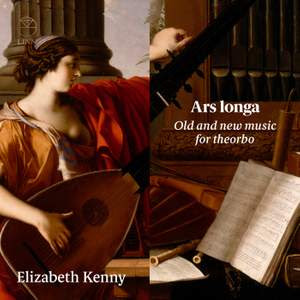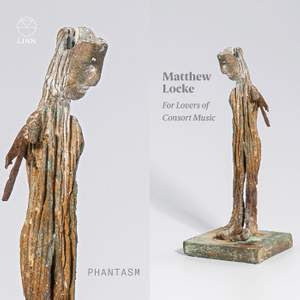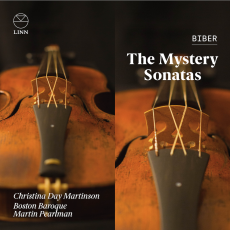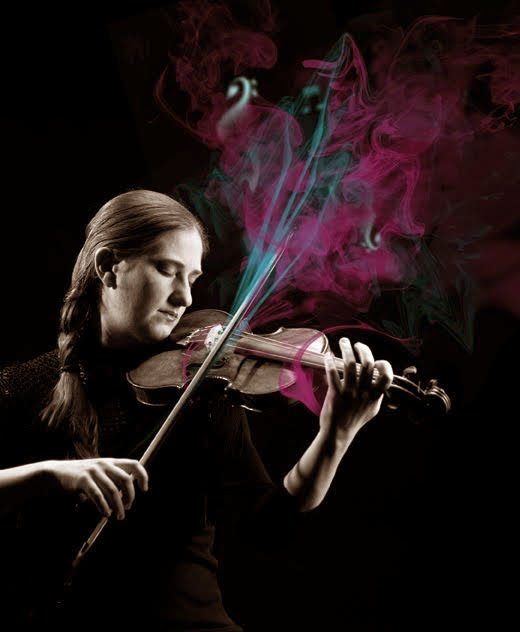Program: #20-18 Air Date: Apr 20, 2020
To listen to this show, you must first LOG IN. If you have already logged in, but you are still seeing this message, please SUBSCRIBE or UPGRADE your subscriber level today.
Consort music of Matthew Locke, the theorbo old and new, and the Mystery Sonatas of Biber.
I. Ars Longa: Old and new music for theorbo (Elizabeth Kenny, theorbo). Linn CD CKD 603.

• The recital takes the listener from the early avant-garde repertoire for the instrument of Kapsperger and Piccinini to the new and imaginative sounds explored by today’s composers.
• Taken from his 2011 work Since it was the day of Preparation … James MacMillan’s motet is a haunting and melancholy piece in which the theorbo acts as an emblem of human fragility and sadness.
• Benjamin Oliver wrote Extending from the inside specifically for Kenny, who relishes the unique challenge of combining elements of funk guitar with Baroque tradition in this premiere recording.
• The second premiere recording is Nico Muhly’s Berceuse, also inspired by Kenny; it exploits the unconventional tuning system and expressive possibilities of the theorbo to powerful effect.
- Toccata 3 cromatica, for lute (from Intavolatura di Liuto) (03:05)
- Toccata No. 10, for theorbo (02:08)
- Chiaccona Cappona alla vera Spagnola, for lute (Intavolatura di Liuto Libro Secondo) (01:42)
- Romanesca con partite variate (06:26)
- Since It Was the Day of Preparation, for bass, vocal quartet, clarinet, horn, cello, harp & theorbo (03:13)
- Corrente No. 1 (from Intavolatura di Liuto, Book 2) (01:28)
- Toccata No. 12, for theorbo (02:00)
- Romanesca con partite variate (03:16)
- Canario for chitarrone (from Book 1 of D'Intavolatura di Chitarrone) (03:33)
- Toccata for lute No. 1 (06:03)
- Passacaglia (from Book 4) (03:09)
- Suite in C minor: Prélude en C sol ut mineur (00:53)
- Suite in C minor: La Plainte, ou Tombeau de Mesdemoiselles de Visée, Allemande de Mr. leur père (04:42)
- Suite in C minor: Courante (01:40)
- Suite in C minor: Sarabande (03:24)
- Suite in C minor: Gigue (02:06)
- Prélude for theorbo in G minor (01:04)
- Les Sylvains de M'Couperin for theorbo (03:34)
- Cycle (01:38)
- First Berceuse (01:48)
- Second Berceuse (01:55)
- Scattershot (01:30)
- Lilt (02:29)
- Stutter (01:33)
- Coda (02:41
II. Matthew Locke: For Lovers of Consort Music (Phantasm with Elizabeth Kenny). Linn CD CKD 5894.

The Flat Consort for My Cousin Kemble, Suite No. 1 in C Minor
1 Fantazie
2 Courante
3 Fantazie
4 Saraband
5 Fantazie
6 Jigg
Consort of Four Parts, Suite No. 3 in F Major
7 Fantazie
8 Courante
9 Ayre
10 Saraband
Consort of Four Parts, Suite No. 1 in D Minor
11 Fantazie
12 Courante
13 Ayre
14 Saraband
Consort of Four Parts, Suite No. 2 in D Minor/D Major
15 Fantazie
16 Courante
17 Ayre
18 Saraband
Consort of Four Parts, Suite No. 6 in G Major
19 Fantazie
20 Courante
21 Ayre
22 Saraband
23 Canon ‘4 in 2’ on a Plain Song
Consort of Four Parts, Suite No. 5 in G Minor
24 Fantazie
25 Courante
26 Ayre
27 Saraband
Consort of Four Parts, Suite No. 4 in F Major
28 Fantazie
29 Courante
30 Ayre
31 Saraband
32 Canon ‘4 in 2’ on the Hexachord
The Flat Consort for My Cousin Kemble, Suite No. 2 in B-Flat Major
33 Fantazie
34 Courante
35 Fantazie
36 Saraband
37 Fantazie
38 Jigg
III. Biber: The Mystery Sonatas (Christian Day Martinson, v./Boston Baroque/Martin Pearlman). Linn CD CKD 501.

First, some background notes on Biber and the sonatas. Born in northern Bohemia, Biber entered the service of the prince-archbishop Karl, Count Liechtenstein-Kastelkorn of Olomouc, in 1668. The prince maintained a substantial musical establishment at his castle in Kroměříč in central Moravia, and was not pleased when, in 1670, Biber abruptly left Kroměříč for Salzburg and employment at the court of its Prince-Archbishop, Max Gandolph. It was customary in Salzburg to commemorate each October events or “mysteries” in the life of the Virgin Mary in a cycle of meditations conducted with the aid of a rosary. Biber’s 15 “Mystery” or “Rosary” sonatas are dedicated to five joyful, five sorrowful, and five glorious events. They were never published, but the manuscript now in the Bavarian State Library in Munich looks like a fair copy prepared for printing, and is illustrated with printed vignettes.
The most extraordinary feature of Biber’s Mystery Sonatas is that they call for elaborate scordatura, or retuning of the violin strings to pitches other than the conventional set, in all but the first piece in the cycle. Scordatura had been used by lute and violin players since the early sixteenth century, and reached its height among south German composers in the 1660s and 1670s. But Biber, an outstanding virtuoso himself, extended the practice further than any composer has ever done. Scordatura tunings enable players to render chord combinations that would be difficult or impossible with customary tunings; they also introduce unique new sonorities when formerly stopped strings are played in open position.
“Make no mistake,” Martinson explained, “scordatura presents formidable difficulties to the player.” For Sonata no. 11, The Resurrection, the normal g-d-a’e’ strings are retuned to sound as g-g’-d-d’, so the hymn tune “Surrexit Christus hodie” (Christ is risen today) sounds in octaves. “Here I have to deal not only with the mind trick of this unusual combination that goes against everything I’ve learned, but also with the physical trick that wipes out normally intuitive hand positions and weight distribution for double stops. Once the instrument is retuned, you’d better let it settle into that tuning, and not risk breaking a string trying to get it back to normal. So I have one violin just for that piece. I have another one for no. 8, “The Placing of the Crown of Thorns,” which tunes the bottom string up a fifth as part of a B flat chord. We will be using six violins in all.”
Although Biber does occasional word painting, as in no. 13 at the “Descent of the Holy Spirit,” Martinson emphasizes that the sonatas are not program music; they convey a general affekt rather than a specific text. In general, dance movements are associated with joyous moments, as in the “Presentation of Jesus in the Temple” (no. 4). “The extremely joyful and uplifting mood of no. 14, “The Assumption of the Virgin,” with its left hand pizzicato, just makes you want to dance. No. 6, the “Agony in the Garden,” oscillates between Christ’s anger at the sleeping disciples and sadness at his suffering to come.” The tuning is a-flat-e-flat-g’-d’, all notes in the scale of a sorrowful C Minor. No. 10, “The Crucifixion,” is technically virtuosic, almost, Martinson says, a Baroque “rock and roll.”
 Unlike the sonatas of Corelli and his Italian contemporaries, which typically have four distinct movements alternating slow-fast-slow-fast, Biber’s sonatas follow the older sectional model in which short passages in contrasting meter and rhythm succeed one another without a break. Scordatura, by favoring certain chord combinations, fixes the key and does not allow for the modulations essential to the structure of later more tonally anchored instrumental music. The cycle concludes with a giant Passacaglia in G Minor for unaccompanied violin that, like the opening sonata, makes no use of scordatura. Here the violin plays its own accompaniment: a passacaglia ground bass, the four-note “la-sol-fa-mi” motive that is also the beginning of a hymn to the Guardian Angel, whose feast was celebrated on October 2nd as part of the rosary devotions. In the manuscript score, the Passacaglia is headed by a picture of a child with his guardian angel. The ground-bass motive, transposed up an octave, is repeated some 65 times below a series of elaborate variations in a truly virtuosic completion to the cycle.
Unlike the sonatas of Corelli and his Italian contemporaries, which typically have four distinct movements alternating slow-fast-slow-fast, Biber’s sonatas follow the older sectional model in which short passages in contrasting meter and rhythm succeed one another without a break. Scordatura, by favoring certain chord combinations, fixes the key and does not allow for the modulations essential to the structure of later more tonally anchored instrumental music. The cycle concludes with a giant Passacaglia in G Minor for unaccompanied violin that, like the opening sonata, makes no use of scordatura. Here the violin plays its own accompaniment: a passacaglia ground bass, the four-note “la-sol-fa-mi” motive that is also the beginning of a hymn to the Guardian Angel, whose feast was celebrated on October 2nd as part of the rosary devotions. In the manuscript score, the Passacaglia is headed by a picture of a child with his guardian angel. The ground-bass motive, transposed up an octave, is repeated some 65 times below a series of elaborate variations in a truly virtuosic completion to the cycle.
Martinson concludes: “This music is directly accessible; it expresses emotion in a simple, direct way that makes it relevant. I’m excited that though it’s over 300 years old, it can come across as innovative, imaginative, and experimental; that there can be novelty in something so old.”
Biber’s sonatas, scored for solo violin and basso continuo, were not intended to be performed on one evening as a cycle, and might well have involved various instruments in the harmonic realization and reinforcement of the partially figured bass. In the upcoming concert, Boston Baroque music director Martin Pearlman will alternate between harpsichord and organ. Other participants will include Michael Unterman, cello, and Michael Leopold, theorbo and Baroque guitar.
- Biber — Passacaglia in G Minor for solo violin
- Biber — Sonata I in D Minor ‘The Annunciation': Praeludium – Aria and 2 variations –
- Biber — Sonata II in A Major ‘The Visitation': [Sonata] / Presto – Allamanda – Presto
- Biber — Sonata III in B Minor ‘The Nativity': [Sonata] / Presto – Courente and double – Adagio
- Biber — Sonata IV in D Minor ‘The Presentation of Jesus in the Temple': Ciacona with 12 variations
- Biber — Sonata IX in A Minor ‘The Carrying of the Cross': Sonata – Courente and 2 doubles – Final
- Biber — Sonata V in A Major ‘The Finding of Jesus in the Temple': Praeludium – Allamanda – Gigue – Sarabande and double
- Biber — Sonata VI in C Minor ‘The Agony in the Garden': Lamento
- Biber — Sonata VII in F Major ‘The Scourging of Jesus': Allamanda and variation – Sarabanda and 3 variations
- Biber — Sonata VIII in B-Flat Major ‘The Crowning with Thorns': Sonata: Adagio / Presto – Gigue and 2 doubles
- Biber — Sonata X in G Minor ‘The Crucifixion': Praeludium – Aria and 5 variations
- Biber — Sonata XI in G Major ‘The Resurrection': Sonata – Hymn ‘Surrexit Christus hodie' and variations
- Biber — Sonata XII in C Major ‘The Ascension': Intrada – Aria tubicinum – Allemanda – Courante and double
- Biber — Sonata XIII in D Minor ‘The Descent of the Holy Ghost': Sonata – Gavotte – Gigue – Sarabanda
- Biber — Sonata XIV in D Major ‘The Assumption of the Virgin': [Sonata] – Arias 1 and 2 – Gigue
- Biber — Sonata XV in C Major ‘The Coronation of the Virgin': Sonata – Aria with 3 doubles – Canzona – Sarabanda and double
Composer Info
Alessandro Piccinini, Sir James MacMillan, Giovanni Girolamo Kapsberger, Benjamin Oliver, Robert de Visée, Nico Muhly, Matthew Locke, Heinrich Biber (1644-1704)
CD Info
Linn CD CKD 603, Linn CD CKD 5894, Linn CD CKD 501